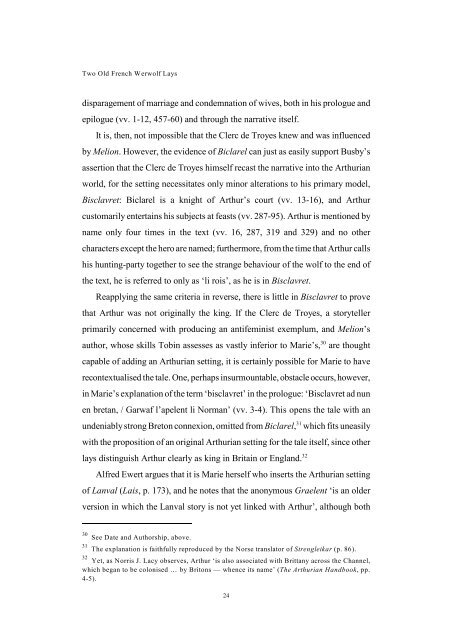Melion and Biclarel - University of Liverpool
Melion and Biclarel - University of Liverpool
Melion and Biclarel - University of Liverpool
Create successful ePaper yourself
Turn your PDF publications into a flip-book with our unique Google optimized e-Paper software.
Two Old French Werwolf Lays<br />
disparagement <strong>of</strong> marriage <strong>and</strong> condemnation <strong>of</strong> wives, both in his prologue <strong>and</strong><br />
epilogue (vv. 1-12, 457-60) <strong>and</strong> through the narrative itself.<br />
It is, then, not impossible that the Clerc de Troyes knew <strong>and</strong> was influenced<br />
by <strong>Melion</strong>. However, the evidence <strong>of</strong> <strong>Biclarel</strong> can just as easily support Busby’s<br />
assertion that the Clerc de Troyes himself recast the narrative into the Arthurian<br />
world, for the setting necessitates only minor alterations to his primary model,<br />
Bisclavret: <strong>Biclarel</strong> is a knight <strong>of</strong> Arthur’s court (vv. 13-16), <strong>and</strong> Arthur<br />
customarily entertains his subjects at feasts (vv. 287-95). Arthur is mentioned by<br />
name only four times in the text (vv. 16, 287, 319 <strong>and</strong> 329) <strong>and</strong> no other<br />
characters except the hero are named; furthermore, from the time that Arthur calls<br />
his hunting-party together to see the strange behaviour <strong>of</strong> the wolf to the end <strong>of</strong><br />
the text, he is referred to only as ‘li rois’, as he is in Bisclavret.<br />
Reapplying the same criteria in reverse, there is little in Bisclavret to prove<br />
that Arthur was not originally the king. If the Clerc de Troyes, a storyteller<br />
primarily concerned with producing an antifeminist exemplum, <strong>and</strong> <strong>Melion</strong>’s<br />
30<br />
author, whose skills Tobin assesses as vastly inferior to Marie’s, are thought<br />
capable <strong>of</strong> adding an Arthurian setting, it is certainly possible for Marie to have<br />
recontextualised the tale. One, perhaps insurmountable, obstacle occurs, however,<br />
in Marie’s explanation <strong>of</strong> the term ‘bisclavret’ in the prologue: ‘Bisclavret ad nun<br />
en bretan, / Garwaf l’apelent li Norman’ (vv. 3-4). This opens the tale with an<br />
31<br />
undeniably strong Breton connexion, omitted from <strong>Biclarel</strong>, which fits uneasily<br />
with the proposition <strong>of</strong> an original Arthurian setting for the tale itself, since other<br />
lays distinguish Arthur clearly as king in Britain or Engl<strong>and</strong>. 32<br />
Alfred Ewert argues that it is Marie herself who inserts the Arthurian setting<br />
<strong>of</strong> Lanval (Lais, p. 173), <strong>and</strong> he notes that the anonymous Graelent ‘is an older<br />
version in which the Lanval story is not yet linked with Arthur’, although both<br />
30<br />
31<br />
32<br />
See Date <strong>and</strong> Authorship, above.<br />
The explanation is faithfully reproduced by the Norse translator <strong>of</strong> Strengleikar (p. 86).<br />
Yet, as Norris J. Lacy observes, Arthur ‘is also associated with Brittany across the Channel,<br />
which began to be colonised … by Britons — whence its name’ (The Arthurian H<strong>and</strong>book, pp.<br />
4-5).<br />
24
















